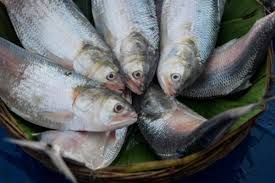
It has been reported that an old project to facilitate the movement of hilsa upstream along the Ganga to its spawning grounds of yore may come to fruition this year.
Daily Current Affairs Quiz 2021
In scientific parlance, the hilsa (Tenualosa ilisha) is an anadromous fish.
That is, it lives most of its life in the ocean, but during the rainy season, when it is time to spawn, the hilsa moves towards the estuary, where the rivers of India and Bangladesh meet the Bay of Bengal.
A large part of the shoal travels upstream in the Padma and the Ganga — some are known to move towards the Godavari, and there are records of hilsa migration to the Cauvery.
Farakka Barrage Lock
Historical records also show that until the 1970s, the hilsa would swim the Ganga upstream to Allahabad — and even to Agra.
But the Farakka Barrage, which became operational on the Ganga in 1975, disrupted the westward movement of the hilsa.
The barrage had a navigation lock that stopped the fish from swimming upstream beyond Farakka. In Buxar on the border of Bihar and Uttar Pradesh, the last recorded catch of the hilsa was made 32 years ago.





